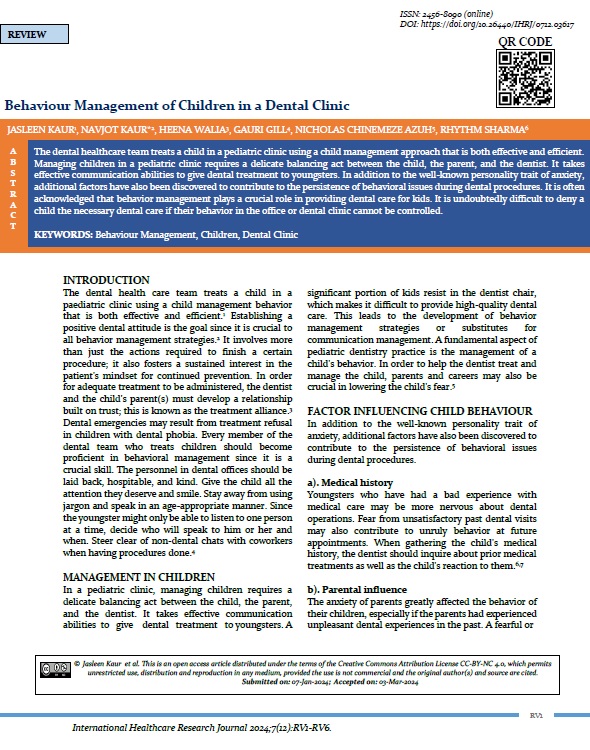Behaviour Management of Children in a Dental Clinic
Abstract
The dental healthcare team treats a child in a pediatric clinic using a child management approach that is both effective and efficient. Managing children in a pediatric clinic requires a delicate balancing act between the child, the parent, and the dentist. It takes effective communication abilities to give dental treatment to youngsters. In addition to the well-known personality trait of anxiety, additional factors have also been discovered to contribute to the persistence of behavioral issues during dental procedures. It is often acknowledged that behavior management plays a crucial role in providing dental care for kids. It is undoubtedly difficult to deny a child the necessary dental care if their behavior in the office or dental clinic cannot be controlled.
Downloads
References
Wright GZ. Behavioural management in dentistry for Children. WB Saundres Company. 1975.
Wright GZ, Starkly PE and Gardner DE. Child management in dentistry, Oxford; wright. 1987.
Frankl SH, Shiere FR and Fogels HR. Should the parent remain within the dental operatory? J Dent child. 1962; 29: 150-163.
Gupta A, Marya CM, Bhatia HP, Dahiya V Freeman R. The case for mother in the surgery. Brit Dent J.1999;186: 610-13.
Wright GZ and Alpern GD. Variables influencing children's co-operative Behavior at first visit. J Dent Child.1971; 23: 124-8.
Bailey PM, Talbot M, Taylor PP. A comparison of maternal anxiety and anxiety levels manifested in the child patient. J Dent Child.1973; 40:277-84.
Johnson R and Baldwin DC Jr. Maternal anxiety and child behavior. J Dent Child.1969; 36:87-92.
Johnson R and Baldwin DC Jr. Relationship of maternal anxiety to the behavior of Young child undergoing dental extraction. J Dent Res.1968; 47:801-5.
Mc Knight-Hanes C, Myers DR, Dushku JC. The use of Behavior management techniques by dentist across practitioner type, age, and geographic region. Pediatric Dent.1993; 15:267-71.
Carson P, Freeman R. Tell show do: reducing anticipatory anxiety in emergency pediatric dental patients. Int J Health Prom Edu.1998; 36:87- 90.
Greenbaum PE, Turner C and Cook, EW. Dentist's voice control: effects on children’s disruptive behaviour. Health Psychology.1990; 9: 546-58.
Roberts JF. How important are techniques? The empathic approach to working with the children. J Dent Child.1995; 62:38-43.
Lencher V and Wright GZ. Non-pharmacotherapeutic approaches to behavior management. In: Wright, G.Z. Behavior management in dentistry for children. Philadelphia, Saunders. 1975.
Satwell R, Simon JF and Simeonsson R. The effects of five preparatory methods upon children Behavior during the first dental visit. J Dent Child.1975; 41:367-75.
Weinstein P and Bathan J. The challenge of fearful and phobic children. Den Clin N Amer.1988.
Johnson R and Machen JB. Behavior modification techniques and maternal anxiety. J Dent Child.1973; 40:272-6.
Ingersoll BD, Nash D, Blount R and Gamber C. Disraction and contingent reinforcement with pediatric dental patients. J Dent Child.1984; 51:203-7.
Ingersoll BD, Nash D, Blount R and Gamber C. The use of contingent audio taped material with pediatric dental patients. J Am Dent Assoc.1984; 109: 717-9.
Machen JB and Johnson R. Desensitization, model learning, and the dental behavior of children, J Dent Res.1974; 53:83.
Melamed, BG, Weinstein D, Hawes R. Reduction of fear - related dental management problems with use of filmed modelling, J Am Dent Assoc.1975; 90:822-6.
Ingersoll BD, Nash D, Blount R and Gamber C. Distraction and contingent reinforcement with pediatric dental patients. J Dent Child.1984; 51:203-207.
Gale EH, Ayer WA. Treatment of dental phobias. J Am Dent Assoc. 1969; 8:130-4.
Fayle EH, Crawford PJM. Making dental treatment acceptable children. Dental Profile. 1997: 18-22.
American Academy of Pediatric Dentistry. Guideline on use of nitrous oxide for pediatric. Pediatric Dent 2011; 33:181-4.
Fayle S and Crawford PJ. Making dental treatment acceptable to children. Dent Profile. 1997;41:178-82.
American Academy of Pediatric Dentistry Guidelines for Behavior management. Pediatric Debt 1998; 20:27-32.
Levitas TC. HOME - hand over mouth exercise. ASDC J Dent Child.1974; 41:178-82.
American Academy of Pediatric Dentistry. Guideline on use of anaesthesia personnel in administration of officebased deep sedation general anaesthesia to the Pediatric dental patient. Pediatric Dent 2011; 33:202-4.

Copyright (c) 2024 Jasleen Kaur et al.

This work is licensed under a Creative Commons Attribution-NonCommercial 4.0 International License.


